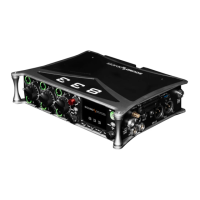Channel Screen
1: Channel Designation and User-Defined Name
Indicates mixer channel and user-defined name. Both are overlaid onto the channel audio meter. When in a Channel Screen, hold
the PFL Switch for about 0.5 s to enter the virtual keyboard and enter a user-defined name for the channel.
2: Channel Meter View
Indicates the audio level of the channel. Metering follows ISO Routing selection, Pre- or Post-fade.
3: Channel Trim Value
Indicates the gain of the channel trim control. The gain range depends on the type of input selected.
● Mic: -inf, +12 to +76 dB
● Line: -inf, -14 to +50 dB
● Dante: -inf, -20 to +50 dB
● SL-2 (Rx): -inf, -20 to +50 dB
● SL-2 (AES): -inf, -20 to +50 dB
● SL-2 (A20-Mini GainForward): -inf, 0 to +60 dB
● AES3: -inf, -20 to +50 dB
● AES42: -inf, 0 to +70 dB
● XL-AES: -inf, -20 to +50 dB
● Returns: -inf, -20 to +30 dB
● Channels 1-6 trim is adjustable using the front panel trim controls.
● Channels 7 & 8 trims are adjustable in the channel screen using the Select knob.
4: Channel Input Source Selection
Indicates which physical audio input source is feeding the channel. Sources can be changed during stop or record.
5: Channel Linking
Indicates the current linking status. The linking options are Unlinked, adjacent channels (eg. 1,2) and adjacent channels Mid Side
(eg. 1-2MS). Linked parameters are: trims, faders, HPF, EQ, delay, limiter, mute, ISO, Bus Send 1 and Bus Send 2. Stereo panning
is 1 to L and 2 to R. MS spread can be adjusted either in the odd channel’s MS balance field by holding */** and rotating Select or by
using the even channel’s front panel trim pot. See Channel Setup menu. When unlinking from a stereo or MS pair, odd and even
channel pans get set back to center.
6: HPF (High Pass Filter)

